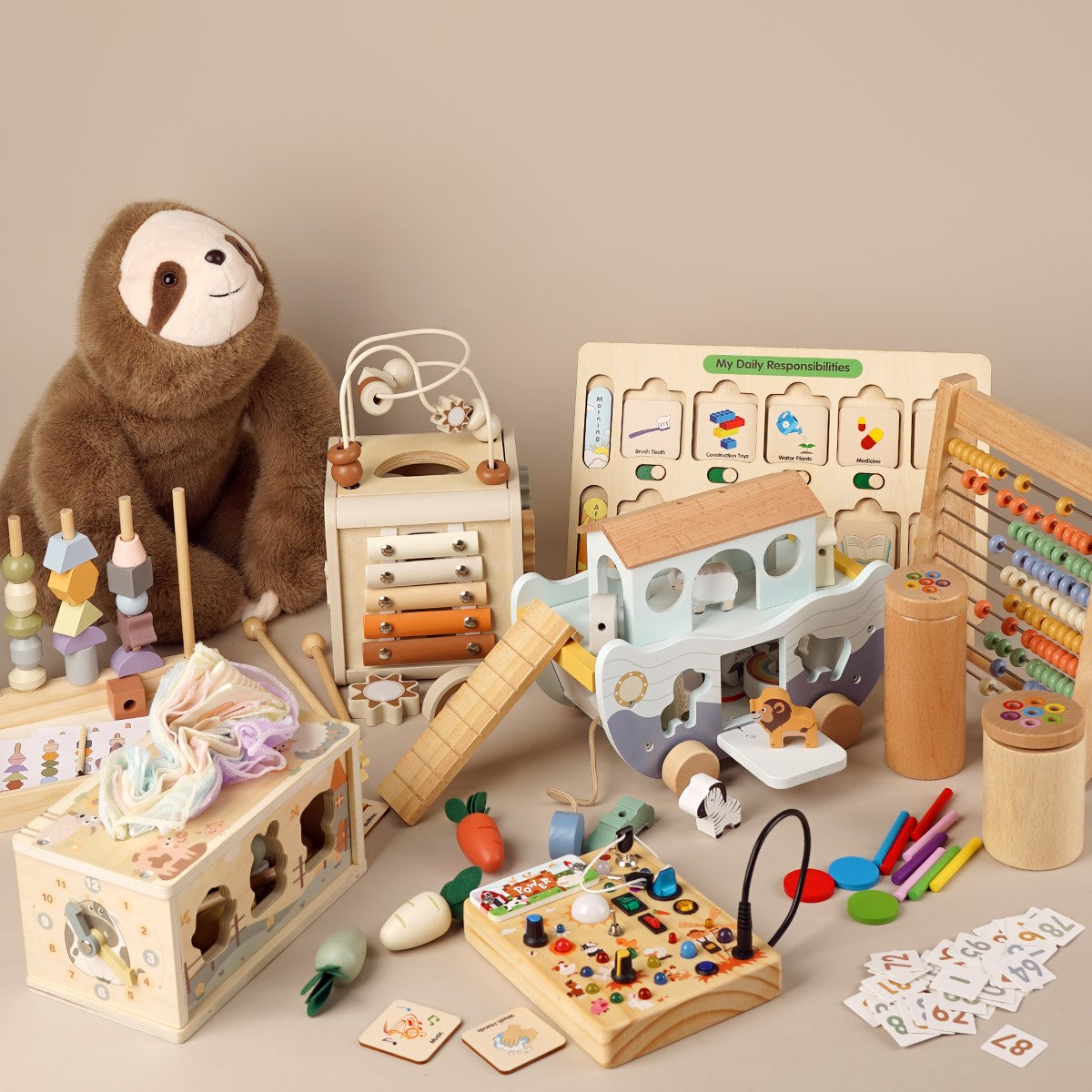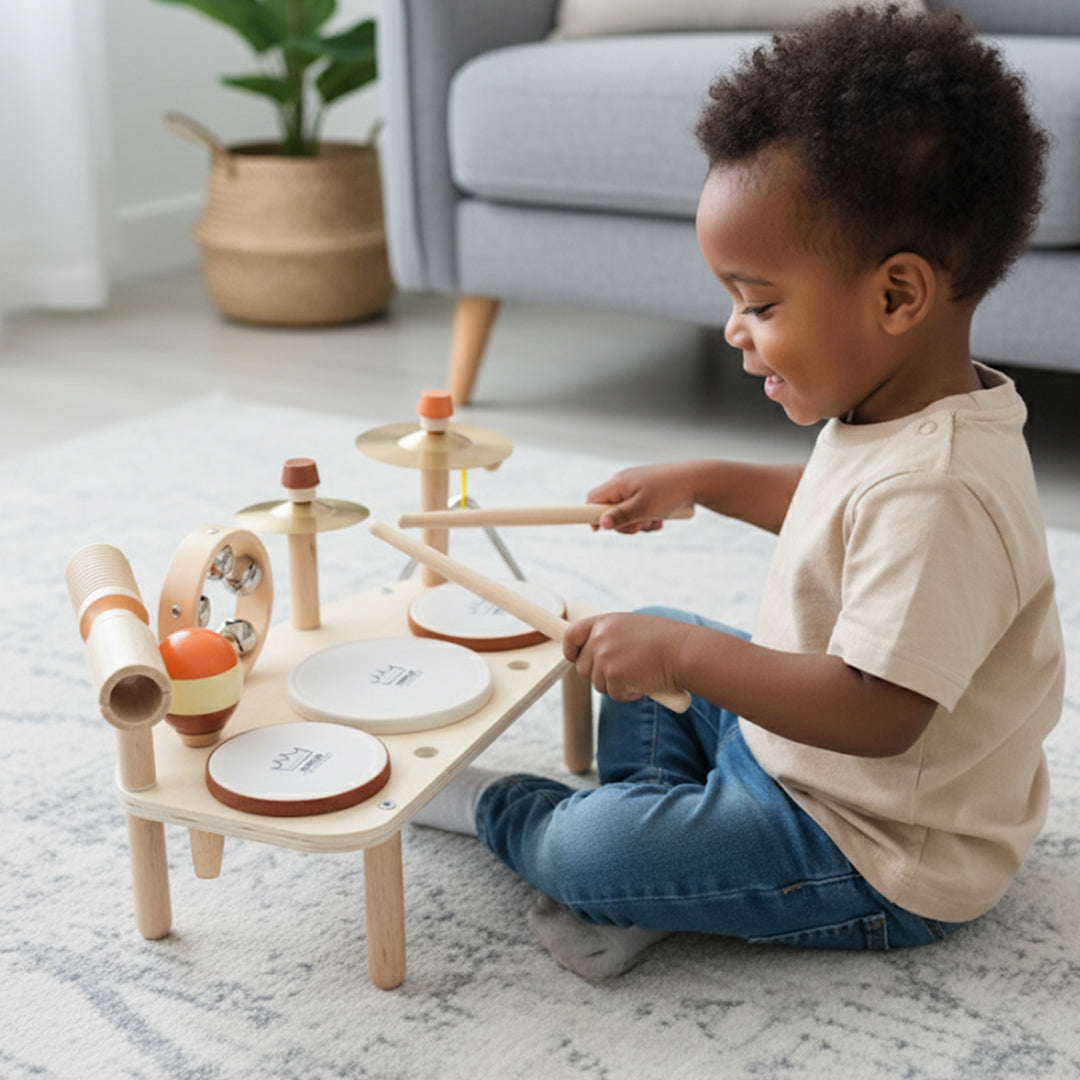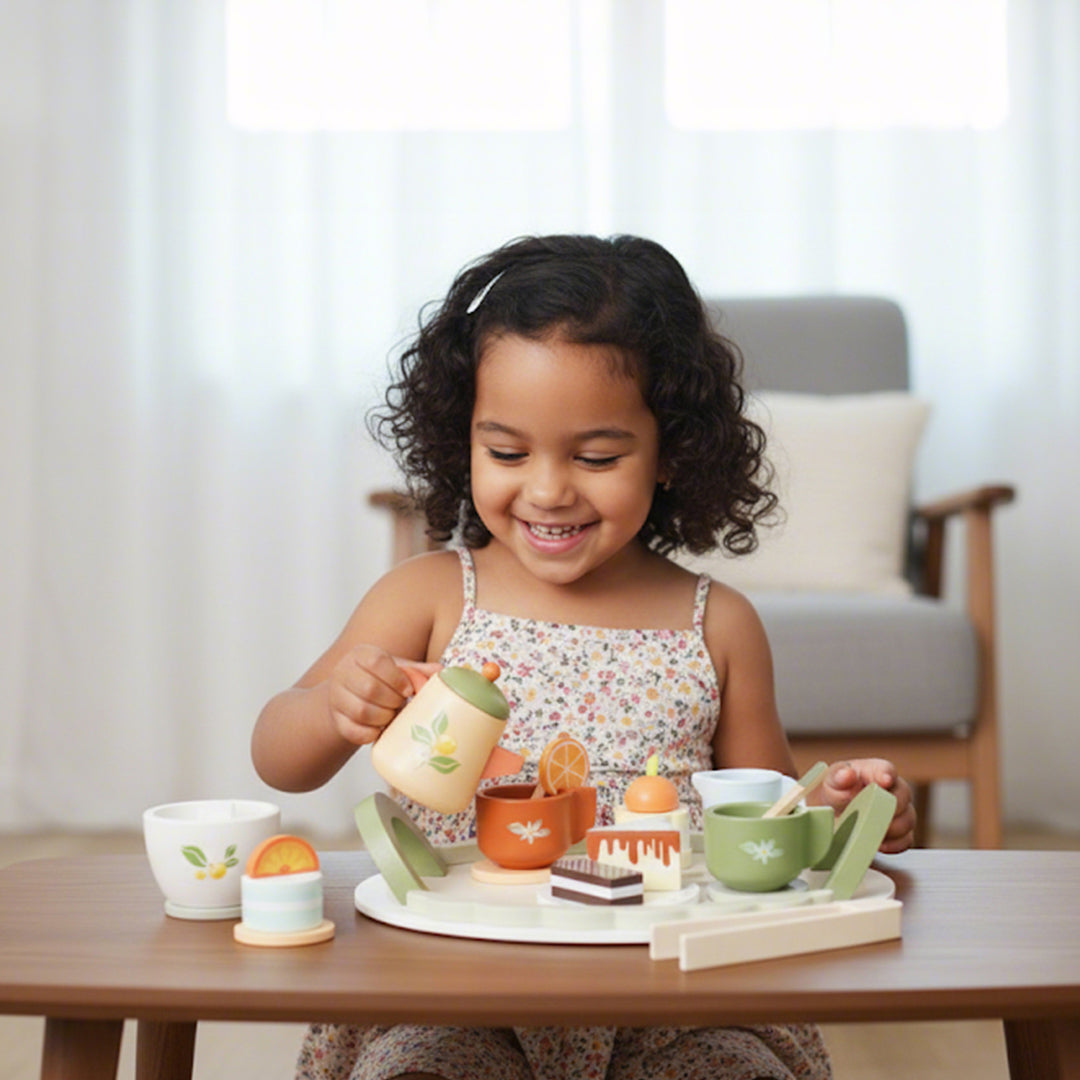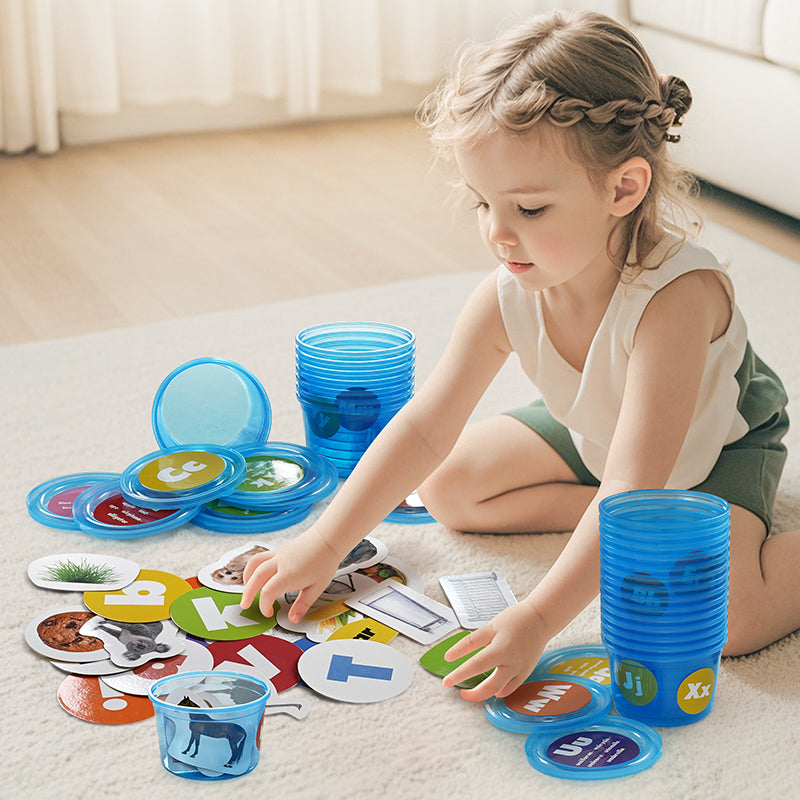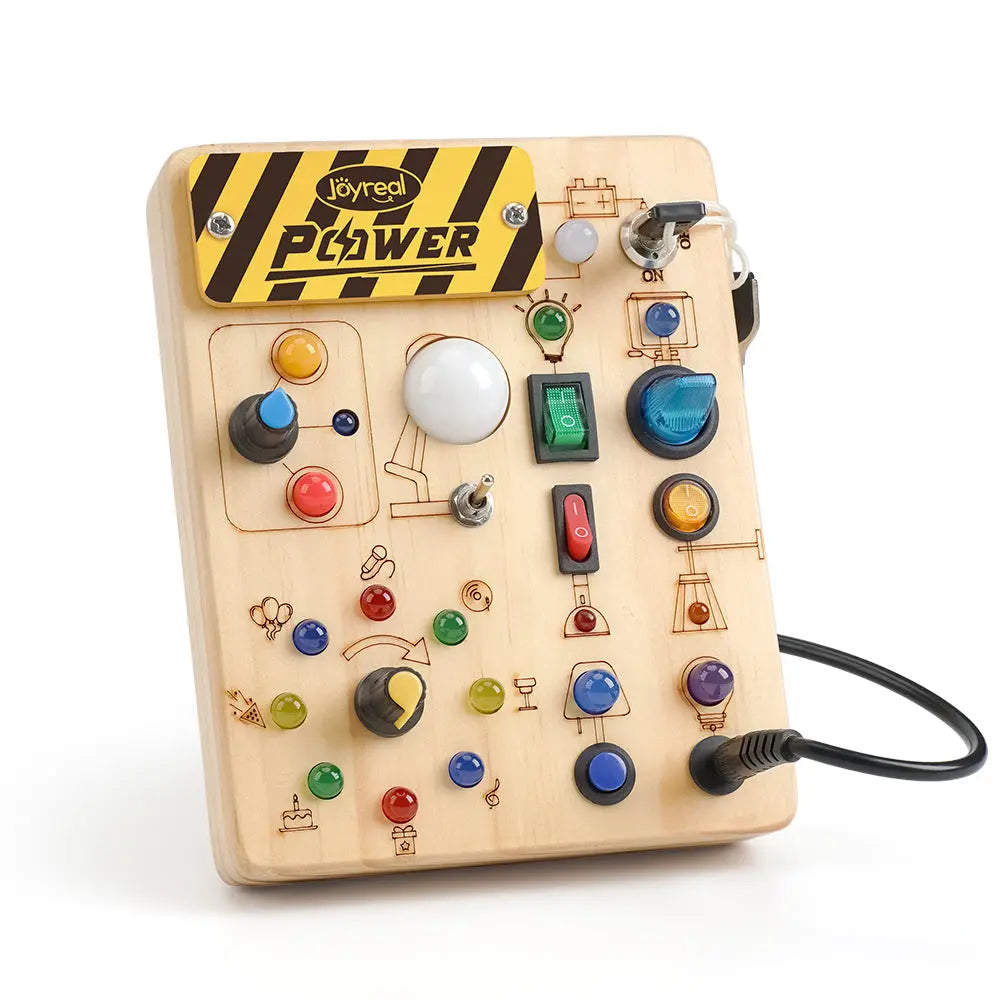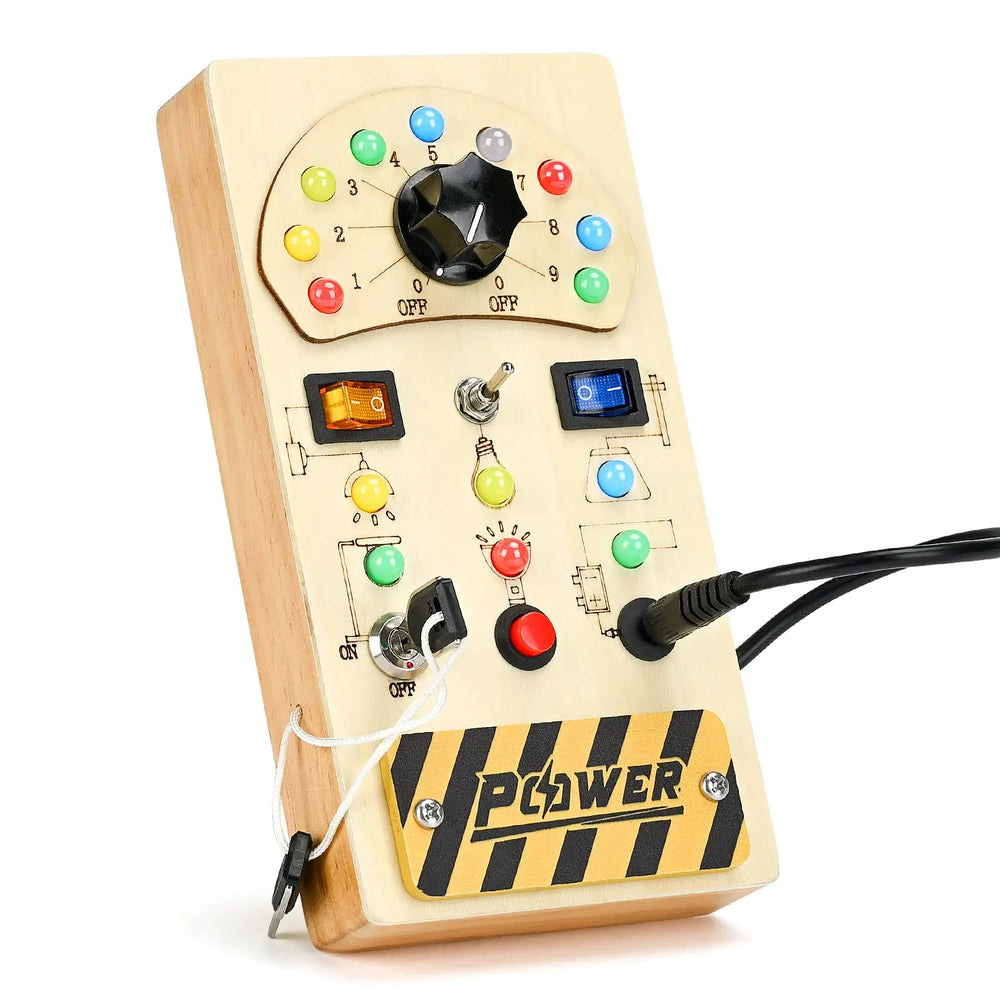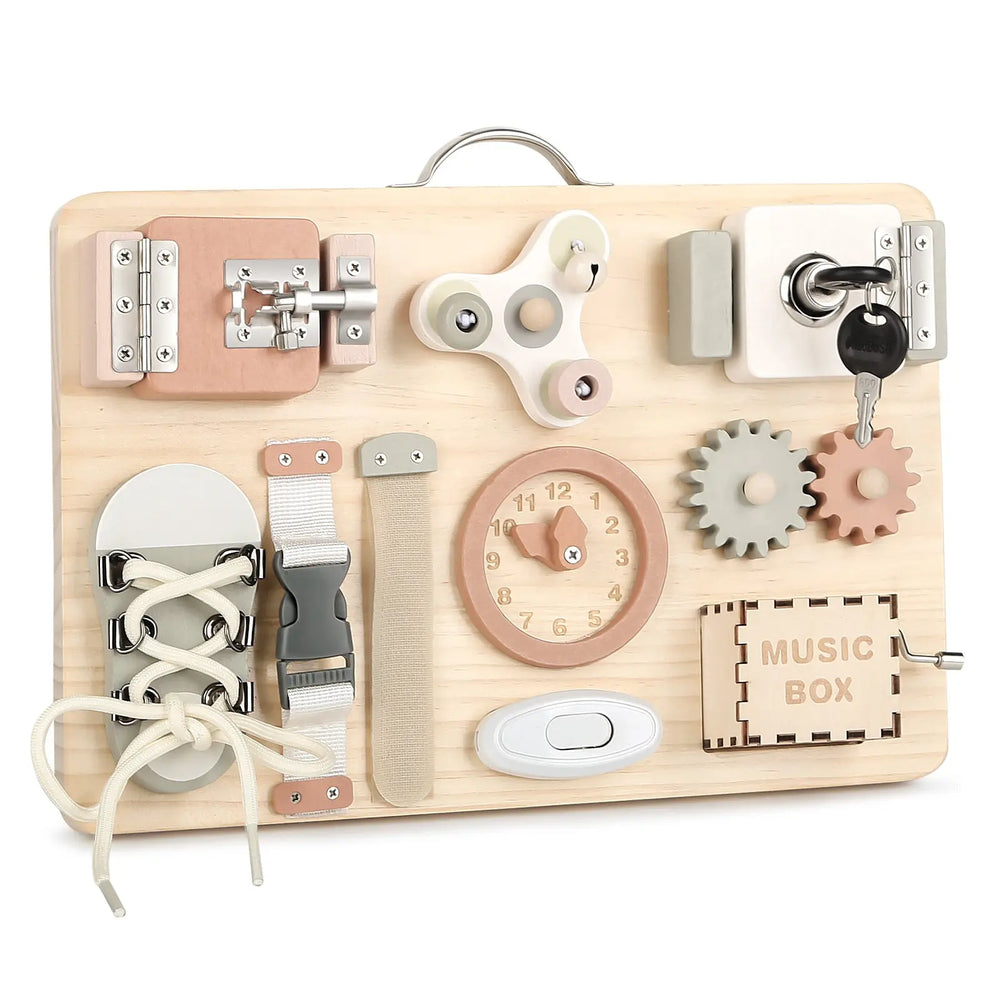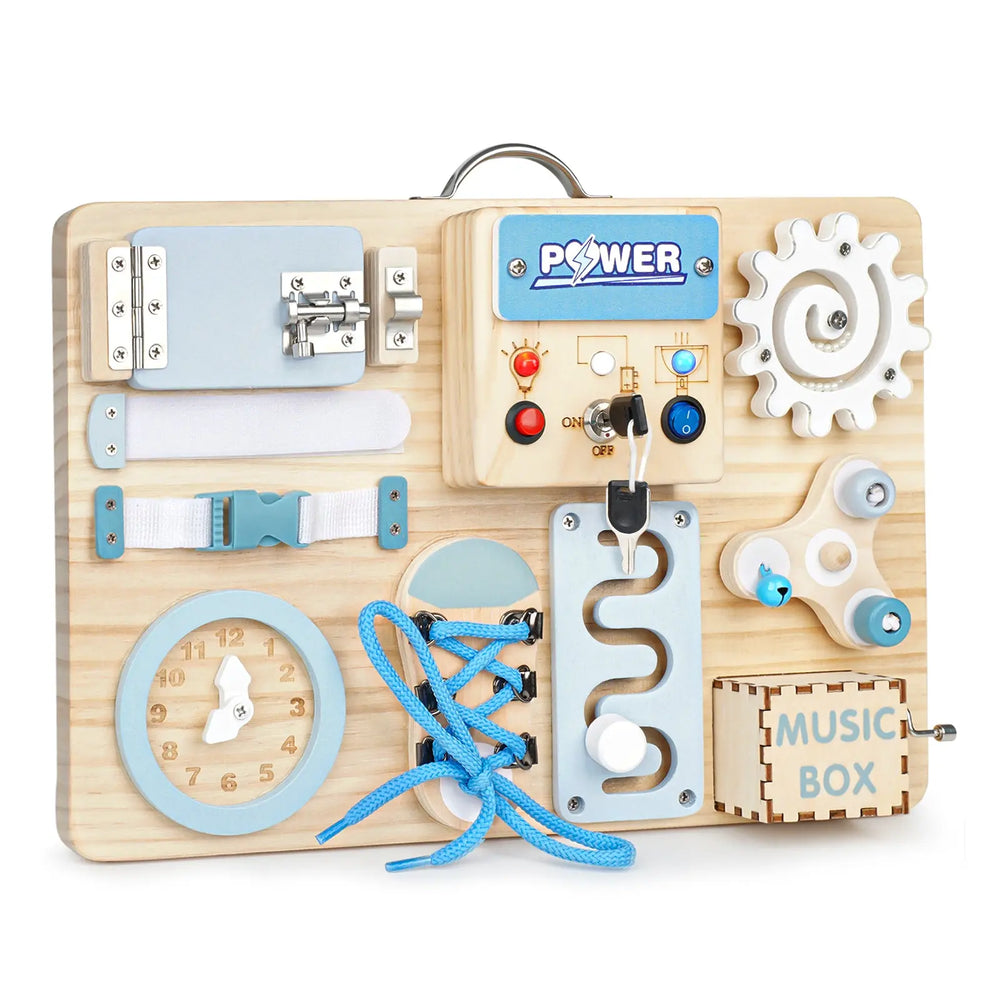DIY Busy Board: A Guide to Making Your Own

Why Make a Montessori Busy Board?
Busy boards offer numerous developmental benefits for young children:
- Fine Motor Skill Development: Activities like zipping, buttoning, buckling, and turning knobs strengthen small muscles in the hands and fingers.
- Problem-Solving: Figuring out how latches work or how to open a door encourages critical thinking.
- Sensory Exploration: Different textures, sounds, and movements stimulate the senses.
- Independence: Children can explore and learn at their own pace.
- Concentration: Engaging tasks help improve focus and attention span.
Materials Needed
Gather these items before you begin. You can find many of these around your house or at a local hardware or craft store.
1. A sturdy base
Plywood, a large cutting board, or a piece of sturdy cardboard (for a lightweight version).
2. Assorted items for activities
- Latches (door latch, cabinet latch, chain lock)
- Switches (light switch, toggle switch) Knobs and handles (door knob, drawer pull)
- Buckles and straps (from old bags or clothing)
- Zippers (from old clothes or fabric scraps) Buttons and buttonholes
- Velcro strips
- Wheels (caster wheels, small toy car wheels)
- Mirrors (child-safe, non-glass)
- Spinners (fidget spinner, lazy Susan bearing)
- Small doors or flaps with hinges
- Locks and keys (simple padlock)
- Gears (plastic gears from old toys)
- Calculator or old phone keypad
- Doorbell (battery-operated)
- Different textured fabrics or materials
3. Tools
- Screwdriver or drill
- Screws, nuts, bolts
- Strong adhesive (E6000 or similar)
- Sandpaper (if using wood)
- Paint or sealant (child-safe, non-toxic)
- Measuring tape
- Pencil
How to Construct your Montessori Busy Board?
1. Prepare the Base
If using wood, sand the edges and surfaces smooth to prevent splinters. You can paint or seal the base with child-safe products if desired. Let it dry completely.
2. Plan the Layout
Arrange the items on the base to get an idea of the placement. Consider the size of the board and leave enough space between items so little hands can easily manipulate them. Ensure a mix of activities.
3. Attach the Items Securely
- For items requiring screws (latches, hinges, knobs), mark the positions with a pencil. Pre-drilling small pilot holes can make screwing easier, especially in wood. Use appropriate length screws that won't protrude through the back. Ensure all screws, nuts, and bolts are tightened and covered if necessary to prevent scratching or injury.
- For items requiring adhesive (Velcro, fabric, mirrors, calculator), apply a strong, non-toxic adhesive to the back of the item and press firmly onto the board. Follow the adhesive manufacturer's instructions for drying time. Ensure they are stuck down well and cannot be easily pulled off.
- For zippers and buttons, you might sew them onto fabric scraps first, then glue or tack the fabric securely to the board.
4. Safety Check
Once everything is attached, carefully inspect the board. Ensure there are no sharp edges, loose parts, or potential choking hazards. Test each item to make sure it is firmly attached. If any screws protrude from the back, cover them with felt or another material.
How Long to Make a Montessori Busy Board?
Creating a Montessori-aligned busy board takes 2-8 hours depending on complexity and preparation. Below is a detailed breakdown:
Key Time Factors (Montessori Edition)
|
Factor |
Time Impact |
Montessori Considerations |
| Material Sourcing | 1-3 hours | Requires natural materials (wood, cotton fabric) instead of plastic |
| Board Preparation | 30-90 mins | Extra time for sanding raw wood edges smooth |
| Activity Selection | 30-60 mins | Focus on real-life skills: zippers, wooden latches, fabric ties |
| Assembly | 1-3 hours | Hand-tools preferred over power tools for authenticity |
| Safety Checks |
20-30 mins |
Non-toxic paints/oils and metal part inspection |
Step-by-Step Timeline
1. Planning Phase (1 hour)
- Sketch layout emphasizing practical life skills
- Select Montessori-approved components (wooden gears, cloth straps)
2. Material Prep (1.5-2 hours)
- Sand wooden base to silky-smooth finish
- Pre-drill holes for screw-mounted elements
- Treat wood with beeswax polish (drying time: 1 hour)
3. Assembly (2-3 hours)
- Secure items with child-safe zinc screws
- Attach fabric elements with non-toxic wood glue
- Install "real work" items: light switch, door knocker
4. Quality Control (30 mins)
- Test all moving parts 50+ times
- Remove any synthetic materials
- Check for splinters/rough edges

Are there any Recommended Brands for Montessori Busy Board?
Joyreal Montessori Busy Board Designs
-
Core Design Principles
Joyreal boards follow strict Montessori guidelines:
- Reality-Based Components (no fantasy elements)
- Natural Materials Only (wood, metal, cotton)
- Skill Progression Sequencing
- Whole-Hand Engagement Focus
- Self-Correction Features
-
Custom Design Options
Growth Adaptive KitsProgressive difficulty packs :
- Stage 1 (12-18mos): Large zippers, ring stacks
- Stage 2 (18-24mos): Buttons, shape sorters
- Stage 3 (2-3yrs): Lacing patterns, number wheels
Themed CollectionsProfession-focused skill builders:
- Little Carpenter: Sandpaper blocks, joiner's mallet
- Future Chef: Apron ties, timer knobs
- Space Engineer: Hose connectors, pressure gauges
Making a busy board is a wonderful way to provide a custom, stimulating toy for your child. Enjoy watching them discover and interact with all the different elements you've chosen!
Maintenance Busy Board Work Flow
Do
- Wipe with damp chamois cloth weekly
- Apply beeswax polish bi-monthly
- Rotate modules every 6-8 weeks
Don't
- Use chemical cleaners
- Submerge in water
- Leave in direct sunlight
Conclusion
Creating a DIY busy board is a rewarding project that combines creativity, practicality, and child development benefits. By carefully planning the design, prioritizing safety, and incorporating age-appropriate activities, you can craft a sensory-rich tool that engages toddlers and preschoolers in meaningful play. A busy board not only fosters fine motor skills, problem-solving, and cognitive growth but also offers endless opportunities for customization to match your child’s interests—whether through vibrant colors, themed decorations, or educational elements like numbers and shapes.
This project is perfect for parents, caregivers, or educators seeking an affordable, hands-on way to spark curiosity and learning. With basic tools and a little imagination, you’ll build a timeless toy that grows with your child while encouraging independence and exploration.
Maybe it will be helpful for you:
Recent Post

What Finally Helped My Toddler Speak Up?
If you’re a toddler mom, you already know how much emotional weight...

Joyreal Christmas Toys Deals 2025
Enjoy instant savings across nearly every category, from early lear...

How Wooden Montessori Toys Support a Sustainable Childhood
Most parents don’t say it out loud, but many feel the same quiet fr...

Top Christmas Gifts to Help Kids Communicate Better This Holiday Season
The holiday season brings joy, family bonding, and endless opportun...

How to Make DIY Printable Communication Boards
Communication is at the heart of every child’s development — and fo...

Top 5 Christmas Gifts That Bring Families Closer (2025 Guide)
Christmas isn’t just about the gifts — it’s about the moments we c...

Top Musical Christmas Gifts for Toddlers & Preschoolers 2025
Why Musical Gifts Are Perfect for Toddlers and Preschoolers Music h...

Joyreal AAC Devices Wholesale Partner
In today’s educational and therapeutic environments, speech therapi...

Joyreal AAC Device – Big Sale for Autism & Speech
Every Voice Deserves to Be Heard Imagine your child looking up at y...

How to Choose Safe & Educational Toys for Christmas 2025
When “Just a Toy” Means So Much More If you’re a parent, you know t...
